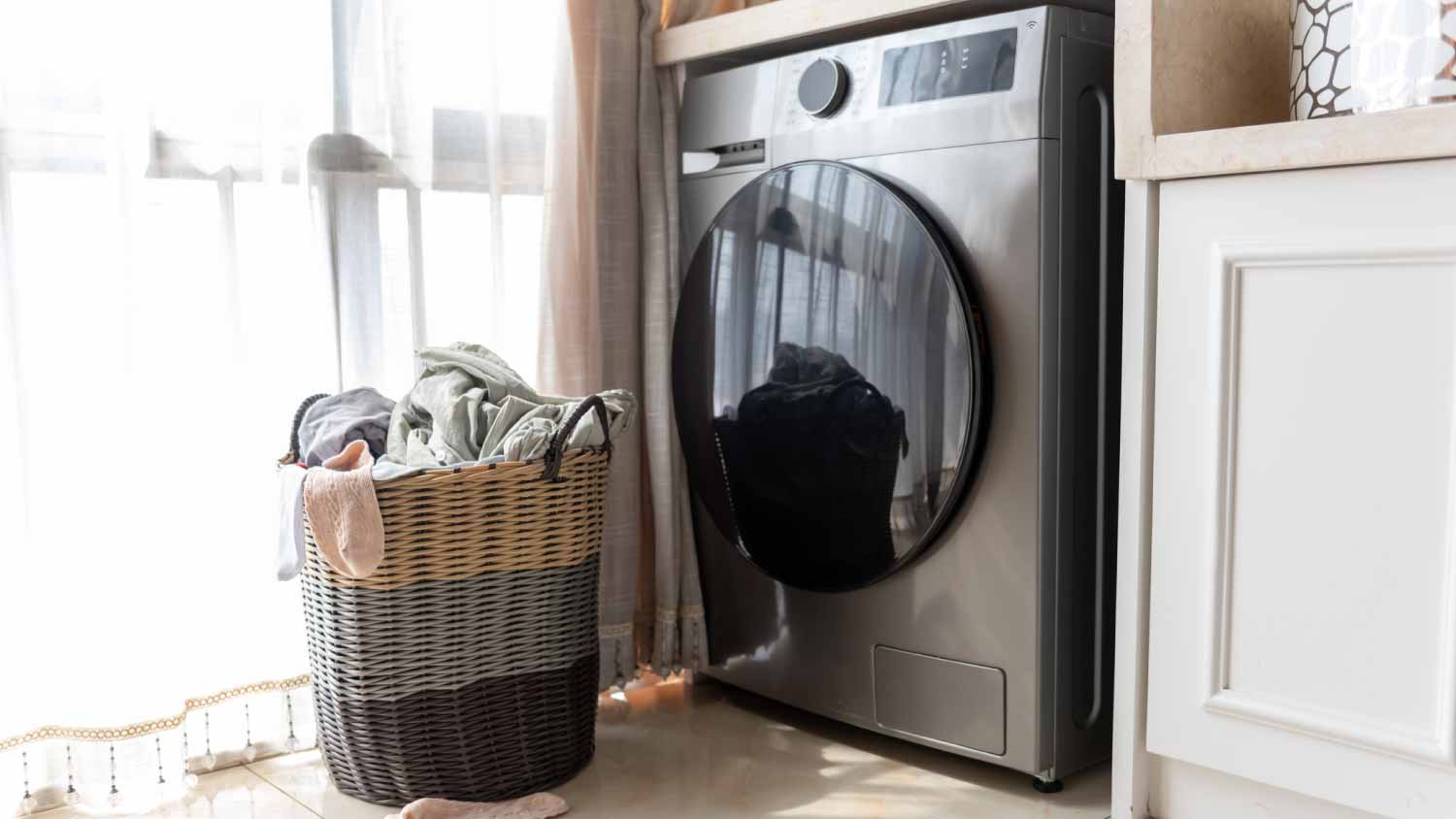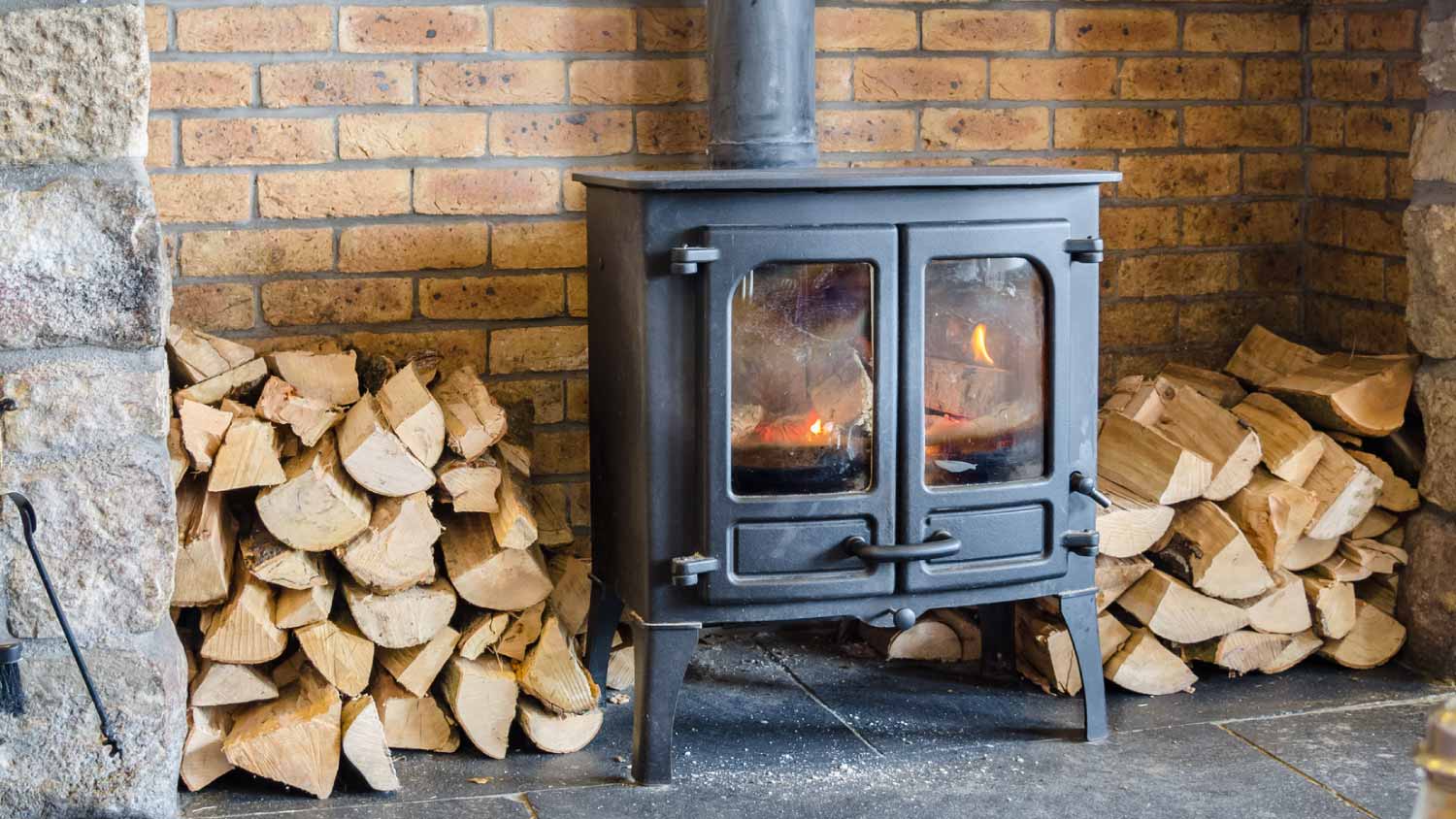Here’s the Average Life Span of Stove Pellets
Make room for a pallet of pellets to stay warm this winter


Pellet stoves are a sustainable, energy-efficient way of heating your home. They can also be quite stylish, creating a cozy atmosphere for your space in more than one way. To keep the fire going, you’ll need to have a good amount of wood pellets on hand. To ensure you won’t run out of fuel in the middle of a frigid winter, it helps to understand how long pellets will last in your pellet stove. Keep reading to learn more about how to get the most out of your pellet stove.
How Long Do Stove Pellets Last?
If you rely on your wood pellet stove for warmth more than ambiance, it’s important to know how long it takes to burn through the pellets before your cache needs to be replenished.
Wood pellets are often sold in 40-pound bags. A pound of wood pellets produces about 8,000 BTUs of heat. It would take around 1.5 pounds of pellets—the equivalent of 12,000 BTUs—to keep the pellet stove burning for one hour at a low setting. If you keep it at this temperature range, you’ll get 26 hours of fuel from one 40-pound bag of pellets. This means that if you were to keep your stove burning continuously, you would go through almost a full bag of pellets per day.
However, you might not burn your stove continuously, so that bag of wood pellets would last longer. On the flip side, you might set your stove to a higher setting, which would deplete your pellets at a faster rate.
How Much Does a Pallet of Pellets Cost?
Wood pellets cost an average of $7.50 for a single bag, but you can save when you buy a ton—yes, a literal ton. There are 50 bags in a ton of pellets. You can get a pallet of pellets for $350, which works out to $7 per bag.
That might seem like an exorbitant amount of wood pellets, but you could burn anywhere between two and five tons per season. You’ll want to err on the side of caution so that you have adequate fuel on hand, but there are additional factors at play when it comes to determining how long your stove pellets will actually last.
If you’ve got the room, it’s worth buying wood pellets in bulk to snag the 50-cent discount per bag. And given that a homeowner will burn through a literal ton of pellets every one to two months during the winter, it helps to have that many on hand.
Factors Influencing How Long Stove Pellets Last

Consider these factors to determine how many stove pellets you’ll actually need to get through the cold season:
Pellet Material
Pellets made from softwoods, like spruce and cedar, burn hotter and longer than pellets made from hardwoods, like oak.
Moisture Level
Stove pellets must be as dry as possible to burn properly. If your inventory has gotten wet or was stored in a humid space, you can try drying them out. But if that doesn’t work, you might have to replace them with new, dry ones.
Stove Efficiency
Like other home appliances, energy efficiency matters. When purchasing a new pellet stove, choose one with a higher efficiency rating to ensure optimal performance.
Temperature
It should come as no surprise that you’ll want to crank up the temperature on your pellet stove when your space feels cold. Depending on the external temperature, this might mean you’re burning through many more pellets than you would on a milder day, so always plan to have extra pellets on hand.
Maintenance
An appliance will always work better when it’s clean, and this is especially true for a pellet stove. When your pellet stove is maintained well, the air will flow better through it, leading to more efficient combustion.
If you're regularly using your pellet stove, you should empty the ash pan, clean out the burn pot, and wipe down the window every week. You should also clean the vent pipes at least once per year, depending on how often you burn.
Signs It’s Time to Replace Stove Pellets
You’ll know it’s time to refill the hopper when the flame runs low or fizzles out completely. But there could come a time when it seems like your stove pellets just aren’t burning like they used to. This might be because the wood pellets you’re using have too much moisture in them. Always store your pellets in a place with low humidity. Otherwise, you might have to toss them and replace them with new, dry pellets.
How to Increase the Life Span of Wood Pellets
If you’re concerned that you’re burning through wood pellets too quickly, here are some ways to conserve fuel:
Maintain the pellet stove at a lower setting.
Rely on another form of heat to either supplement the stove or give it a rest completely.
Store the pellets in a cool, dry place.
Repairing vs. Replacing a Pellet Stove
If the wood pellets are fine but the pellet stove itself isn’t working properly, it might be time to call a pro at a wood stove company near you to troubleshoot. It might just be that a part of the pellet stove needs repair or replacement, which might be a quick, budget-friendly fix or perhaps even free if it’s under warranty.
However, if you’re faced with a hefty repair bill because a major component is malfunctioning, then it’s time to consider the cost of repairing it and replacing it completely with a new, more efficient model. When weighing the pros and cons of getting a new pellet stove, keep in mind that more efficient models will save energy and, therefore, money.
Frequently Asked Questions
The average cost of pellet stove installation is $2,300, although the actual cost may range between $1,000 and $3,600. Materials cost between $1,000 and $3,000, and the rest is labor costs. You’ll also have monthly costs when using your pellet stove to cover wood pellets and your electricity bill.
It’s not difficult to dispose of wood pellet ash, but you should always let it cool completely before disposal to avoid it sparking a fire. If you’ve got an energy-efficient pellet stove, there shouldn’t be much to empty from the ash box, anyway. However, once the ash has cooled, you might consider composting it or simply adding it to your garden or plant soil. The ash is full of minerals, not chemicals, so it’s a wonderful fertilizer for grass and plants.



.jpg?impolicy=leadImage)

- Appliance Repair Companies
- Washing Machine Repair
- Dryer Repair
- Refrigerator Repair
- Dishwasher Repair
- Oven Repair
- Wood & Pellet Stove Repair
- Freezer Repair Services
- Wood Stove Services
- Gas Stove Repair
- Emergency Appliance Repair Companies
- Ice Maker Repair
- Gas Appliance Repair
- GE Appliance Repair
- GE Refrigerator Repair
- GE Dryer Repair
- GE Dishwasher Repair
- GE Washing Machine Repair
- Samsung Appliance Repair
- Samsung Refrigerator Repair
- Samsung Dryer Repair
- Samsung Washer Repair
- Samsung Dishwasher Repair
- Samsung Oven Repair
- Whirlpool Repair
- Whirlpool Refrigerator Repair
- Whirlpool Washer Repair
- Whirlpool Dryer Repair
- Whirlpool Oven Repair
- Maytag Appliance Repair
- Maytag Refrigerator Repair
- Maytag Washer Repair
- Maytag Dryer Repair
- Maytag Dishwasher Repair
- Kitchenaid Appliance Repair
- Kitchenaid Oven Repair
- Kitchenaid Refrigerator Repair
- Kenmore Appliance Repair
- Kenmore Dishwasher Repair
- Kenmore Washer Repair
- Kenmore Dryer Repair
- LG Refrigerator Repair
- Bosch Appliance Repair
- Kenmore Refrigerator Repair
- LG Appliance Repair Services
- GE Microwave Repair
- Electrolux Appliance Repair
- Electrolux Washer Repair
- Kitchenaid Dishwasher Repair Services
- Wood Stove Inspection
- Dishwasher Installation
- Trash Compactor Repair











